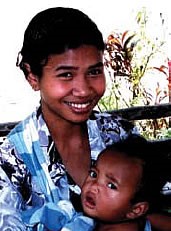Semai, Central Sakai in Malaysia

Photo Source:
Copyrighted © 2026
Southeast Asia Link - SEALINK All rights reserved. Used with permission |
Send Joshua Project a map of this people group.
|
| People Name: | Semai, Central Sakai |
| Country: | Malaysia |
| 10/40 Window: | Yes |
| Population: | 65,000 |
| World Population: | 65,000 |
| Primary Language: | Semai |
| Primary Religion: | Ethnic Religions |
| Christian Adherents: | 6.00 % |
| Evangelicals: | 3.33 % |
| Scripture: | New Testament |
| Ministry Resources: | Yes |
| Jesus Film: | No |
| Audio Recordings: | Yes |
| People Cluster: | West Malaysia Indigenous |
| Affinity Bloc: | Malay Peoples |
| Progress Level: |
|
Introduction / History
Semais are by far the most numerous of the nineteen Orang Asli people groups in Peninsular Malaysia. The government categorizes them under the Senoi subgroup. They are about a quarter of the entire Orang Asli population and almost two thirds of the Senoi.
Many Semai refer to themselves differently, like mai darat (People of the Hinterlands). Sometimes in self-deprecation, a Semai will use a base Malay word, sakai (slave), when talking about how his people are in comparison with the other peoples of the Malayan peninsula. However, on the lips of a non-Semai the term is offensive.
They seem to know very little about their own history beyond the fact that they were the original inhabitants of the peninsula. Semai villages are found in the states of Pahang, Perak, Selangor, and Kelantan.
What Are Their Lives Like?
Since settling down on the peninsula, the Semai's main means of livelihood has evolved into a mixed system of arboriculture, shifting cultivation, hunting, and trading forest products. Farming and hunting are their main economic activities. The more traditional Semai live in small, isolated camps on mountain slopes at high altitudes and grow mainly mountain rice, millet, and maize. They also hunt, fish, and gather. Others live lower down and grow mainly mountain rice. Yet others, who are quite adapted to Malay society, live even lower down the mountains, cultivating mountain rice and wet rice. Their literacy standard is, however, higher compared with the other Orang Asli tribes.
For the Semai the point of eating is to feel full. For a meal to be filling, it must include a starch dish, preferably rice. When rice is scarce, roasted or boiled tapioca root may be substituted. To eat meat, fowl, or fish without a starch dish is ridiculous to the Semai.
What Are Their Beliefs?
The Semai are largely animists, but a large minority professes Christianity. Many professing Christians, however, are still gripped by their old beliefs. They are more likely to believe in witchcraft than the Semai.
The Semai's main festival is the Genggulang. It is a festive ritual to appease land spirits for a good harvest and is still observed in many places where the people worship the rice spirit. In this ritual, the spirits are offered sacrificial chickens, flowers, and unhusked rice. Now, the festival has lost much of its religious meaning. It has become more of a cultural event, similar to the way the Chinese celebrate Lunar New Year or Westerners celebrate Christmas. The Semai tend to be unconcerned and skeptical about religious dogma. For example, people describing life after death almost always conclude by saying, "That's just a story of bygone days. I don't believe it."
What Are Their Needs?
The Semai people need to be introduced to modern farming methods that are more practical and productive, replacing their traditional practices. This would help increase crop yield and sale value.
Prayer Points
Pray for the needed agricultural training for the Semai community.
Pray for local believers who will relate to the spiritual needs of the Semai.
Pray for the Lord to bless the Semais materially and spiritually.
Pray for their churches to be blessed by the Holy Spirit, and that they will send a team of workers to animistic and Muslim peoples.